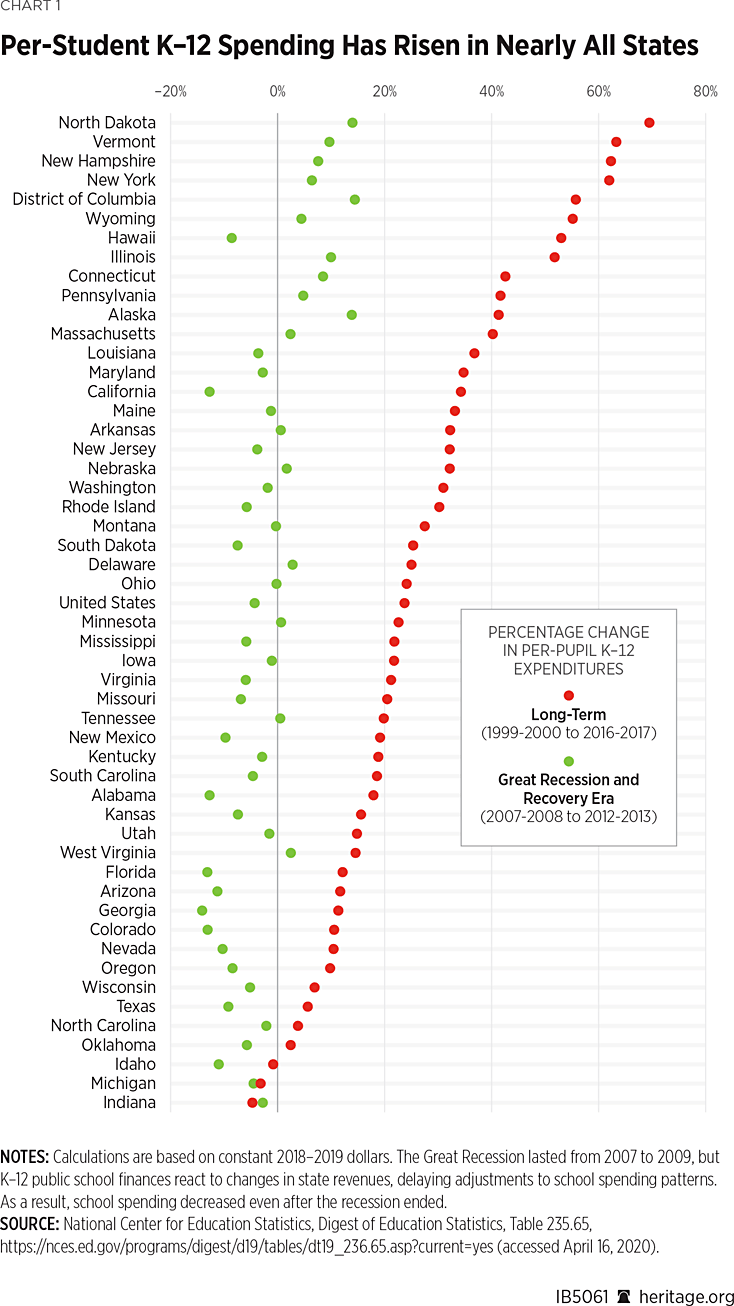Nearly every economic indicator, from the stock market to unemployment and beyond, suggests that a global financial crisis is imminent. Diane Swonk, chief economist at Grant Thornton, told CNBC, “It’s almost like a meteor hit the entire planet and we have to now deal with the fact that we’ve been knocked off our axis.”REF But while every parent, family, and taxpayer may be affected by an economic downturn, education special-interest groups are demanding that Washington bail them out now, regardless of future tax or spending needs.
Teachers’ unions, school board associations, and other industry associations say the $13.5 billion that Congress included in the Coronavirus Aid, Relief, and Economic Security (CARES) Act, signed into law on March 27 to aid K–12 schools during the pandemic, was merely “a step in the right direction.”REF They claim that at least $175 billion—some 13 times more than the K–12 portion of the CARES Act—is required.
Washington accounts for just 8.5 percent of all K–12 spending annually—approximately $60 billion in 2015–2016.REF The CARES Act’s contribution to K–12 budgets and new spending for which interest groups are advocating are more than triple Washington’s current annual outlays for local schools. Washington’s constitutionally limited role in K-12 affairs aside, current federal budget deficits are estimated to be as high as $3.6 trillion and long-standing debts total more than $24 trillion. Washington cannot increase K–12 spending and maintain spending in other critical areas such as defense without budget adjustments that lawmakers so far have been unwilling to make.REF The current union demands are another example of spending proposals that ignore Washington’s appropriate role in K–12 schooling and will harm future generations.
K–12 Schools and the Economy
No individual or industry—public or private—can be completely immune to economic fluctuations. Public schools receive taxpayer spending from state, local, and federal sources, all of which are sensitive to changes in tax revenue. State budgets vary, but public school budgets account for 25 percent–50 percent of state general funds. As a result, when state officials cut spending, there are few options available to lawmakers before school spending is affected.REF
If schools face a recession, they will be doing so alongside most other sectors of the economy, but as Marguerite Roza of the Brookings Institution has explained, the “looming financial shortfall won’t be felt equally” in all districts or states.REF Districts that are more reliant on state tax revenue (as opposed to property taxes) are more subject to fluctuations, as demonstrated by spending changes over the past two decades, including during the Great Recession (Table 1).

Many educators remember the last recession and the spending trade-offs that were required to sustain public services. Any reductions in K–12 spending from this crisis were short-lived, however, and schools now spend $15,424 per K–12 student—more than at any other point in U.S. history even after adjusting for inflation.REF According to the National Association of State Budget Officers, 2019 marked the ninth consecutive year of “moderate state spending and revenue growth.”REF The level of state revenue growth means that the federal stimulus after the last recession cannot explain either the historic per student spending now or the gains demonstrated in Table 1. Even the Great Recession resulted in just a temporary suspension of routine overall spending increases for K–12 schools.
K–12 Special Interests’ Reputation for Unreasonable Demands
Special interests’ new plan for more federal spending for K–12 schools should be considered alongside their record of making unfeasible requests. Nowhere in their recent letter to Congress or in previous campaigns for tax increases have national union offices or other groups defined a number that will satisfy them. This perspective is shared by state and district teachers’ union branches, as evidenced by the teacher strikes and lobbying campaigns for more spending that have persisted in the midst of increases. For example:
- After the teacher strikes in Oklahoma in 2017 and Kentucky in 2018, these states could not afford the teacher raises and other union demands, and lawmakers had to raise taxes.REF
- After a teachers’ union strike ended in Los Angeles in January 2019, the Los Angeles Unified School District superintendent said he did not know how the district would pay for the demands included in the settlement.REF According to local media, “One year after the teacher’s strike…Los Angeles Unified Superintendent Austin Beutner says that the district still faces fundamental financial problems, and continues to spend more money than it is receiving from the state.”REF
- After Chicago teachers went on strike in 2019, Illinois Policy explained that the settlement places “unsustainable demands” on the district’s pension system and that the new teacher contract calls for between $627 million and $1.5 billion in additional spending (with no firm conclusion on a number). The district has “no real plan to fix its problems.”REF
Thus, teachers’ unions and their allies push for taxpayer spending without regard to other areas of state and local budgets and without concern for the effect on future generations of taxpayers.
To make matters worse, some unionized teachers have delayed any instruction online after pandemic-related school closures in some areas, such as California, so that they can renegotiate contracts.REF Even weeks after school closures in Washington State, one district has still posted a message to families saying it does not have any plans for online learning because of, among other things, “collective bargaining agreements.”REF
Options for Reform
In the face of tight economic times, policymakers have available several reforms that are more effective than unfunded promises for new spending and that would help schools to weather economic challenges. Specifically, action is needed in three areas:
- Union Contracts. State and local policymakers should prepare to continue this school year online, resume classes in person when deemed appropriate, and consider summer classes. Unions should not be allowed to slow district responses to continuing instruction during the pandemic and concurrently make new spending demands. Likewise, should schools close again in the fall if there is another outbreak, parents should not have to wait for contracts to be revised before learning can continue. Unions should be held responsible for delays in instruction due to contract negotiations, and state and local officials should consider student needs and renegotiate union contracts that interfere with flexible learning solutions.
- Spending Flexibility. Federal lawmakers should extend the waivers and spending flexibility provided through the CARES Act.REF The proposal allows schools to carry forward unused Title I spending and repurpose existing professional development spending for online instruction, for example. Federal and state lawmakers should allow such flexible spending to continue and give schools more discretion to devote resources to areas of need. Experts on school finance and pensions agree that school systems need spending reforms that will help them prepare for the next economic downturn.REF The spending flexibility offered through the CARES Act is an example of systemic change that could help schools both now and in the future.
- Administrative Bloat. Districts should focus spending on instruction and trim overhead. Between 1950 and 2015, the ranks of administrators grew by 709 percent, far outpacing the hiring of teachers or student enrollment increases.REF Fewer administrator salaries would help districts to direct spending to students and educators. Also, administrator early retirements will not help pressing pension problems, so lawmakers should consider moving to direct contribution plans to deal with spiraling pension costs.
Conclusion
The Wall Street Journal has reported that while the “full impact of the coronavirus pandemic may take years to play out…one outcome is already clear: Government, businesses, and some households will be loaded with mountains of additional debt.”REF While calls for responsible spending may sound trite, these reminders bear repeating: “Borrowing now amounts to a transfer of economic activity from the future to the present.”REF It is fiscally irresponsible to consider new money for K–12 schools on the order of three times current federal expenditures while staring down a global recession without changes in existing spending patterns.
The NEA and its allies have told Congress that the coronavirus “is destined to have a lasting impact on our way of life.”REF If policymakers are not careful, that impact could be unsustainable and outsized federal spending on K–12 schools.
Jonathan Butcher is Senior Policy Analyst in the Center for Education Policy, of the Institute for Family, Community, and Opportunity, at The Heritage Foundation.



